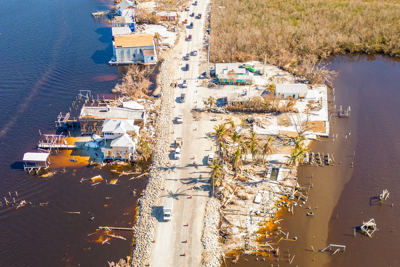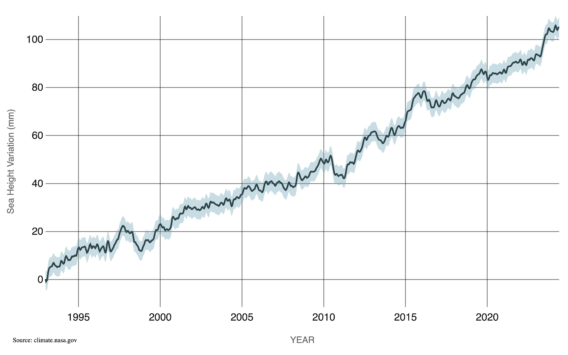On the campaign trail this summer, former President Donald Trump has routinely cast doubt on climate change by falsely claiming that the oceans will rise just “one-eighth of an inch over the next 400 years.” He’s previously used the same measurement over a period of 250 years. In fact, the current rate of sea level rise is already a little more than one-eighth of an inch each year.

“The biggest threat is not global warming, where the ocean’s going to rise one-eighth of an inch over the next 400 years … and you’ll have more oceanfront property, right?” Trump said in an Aug. 12 interview on X with Elon Musk, the platform’s owner. “The biggest threat is not that. The biggest threat is nuclear warming, because we have five countries now that have significant nuclear power and we have to not allow anything to happen with stupid people like [President Joe] Biden.”
Since June, Trump has used the same figures at least three other times to incorrectly minimize — and even question the reality of — current and projected sea level rise, including most recently at an Aug. 17 rally in Wilkes-Barre, Pennsylvania.
“The oceans will rise one-eighth of an inch over the next 400 years, but they don’t talk about a madman that’s building nuclear missiles right now. That’s your real global warming. It’s not this,” he said. “Your global warming is going to be nuclear weapons. Nobody talks about that. They don’t ever mention it, but they talk about an ocean that’s rising, which will give you slightly more beachfront property if it happens.”
On another occasion, at a rally in Virginia in late June, the former president upped the time frame to 497 years.
Trump’s latest sea level rise claims are even more extreme than his previous assertion, in 2019, that sea level rise would total one-eighth of an inch “within the next 250 years,” which we fact-checked at the time. Last year, Trump also used the absurdly low rates of one-eighth of an inch over 300 years and one-hundredth of an inch over 350 years.
It’s unclear, as it was in 2019, whether Trump is using the numbers in earnest. His campaign did not respond when asked to clarify. The takeaway, however, is clear: that the risks of climate change are negligible or even nil, when in fact, they are very much real.

Sea level rise is one of the most visible and devastating impacts of global warming. Contrary to Trump’s suggestion that it might only lead to “more beachfront property,” rising sea levels increase coastal flooding, including storm surges, which puts lives and infrastructure at risk.
Rising sea levels also contribute to coastal erosion, meaning less beach — not more. For every inch of sea level rise, approximately 100 inches of beach are lost, according to NASA oceanographer and climate scientist Josh Willis.
Sea level rise primarily occurs because higher temperatures are melting land ice, which adds water to the oceans, and because warmer temperatures expand the volume of the existing water. (A much smaller contributor is the movement of water on land, such as in lakes and aquifers, to the seas, mostly via groundwater depletion.) The planet is already significantly hotter than it used to be, and it continues to warm, due to past and present releases of heat-trapping pollution, primarily from the burning of fossil fuels.
Current and Projected Levels of Sea Level Rise
According to the latest data from NASA, the current rate of global sea level rise is 4.2 millimeters, or 0.17 inches, per year. That’s already a bit above one-eighth of an inch annually — and far from Trump’s estimates of that amount over centuries.
Satellite data show that just since December 2019 — when Trump made his claim of one-eighth of an inch over 250 years — the global sea level has already risen more than five-eighths of an inch.
Sea level rise has accelerated in recent years, and that trend is expected to continue. For example, for much of the last century, oceans rose by an average of 1.4 millimeters, or 0.06 inches, per year, according to the National Oceanic and Atmospheric Administration. But between 2006 and 2015, the average more than doubled to 3.6 millimeters, or 0.14 inches, per year.

Specific locations may be above or below this average, due to a variety of factors, including ground settling, ocean currents and erosion.
Projections for future sea level rise further dwarf Trump’s already low figures. Per a 2022 NOAA technical report, global sea levels are projected to rise 1 foot above 2000 levels by 2100, even in the most optimistic scenario. Those projections grow to 3.3 feet in the intermediate scenario and balloon to 6.6 feet in the high scenario.
Sea level rise over the next 30 years is projected to be the same as the total rise over the past 100 years, according to the report. By 2050, for example, the report says that the sea level along the U.S. coastline is expected to be on average 10 to 12 inches higher than in 2000, with the Gulf and East coasts experiencing even larger increases. This will quintuple the risk of “major” flooding and make “moderate” flooding more common than “minor” flooding is today.
The latest report from the Intergovernmental Panel on Climate Change, from 2021, provides similar projections: a 7-inch increase in global sea levels by 2050 and a 15-inch rise by 2100, assuming low emissions, relative to levels in 1995 to 2014. Those rise to 9 inches and 30 inches by 2050 and 2100, respectively, under high emissions. These estimates do not factor in various ice sheet processes that are highly uncertain but could — in an unlikely but possible scenario under high emissions — more quickly melt the ice sheets in Antarctica and Greenland and add another 3.3 feet or more of sea level rise by the end of the century.
As an FAQ for the report explains, past and present emissions have virtually guaranteed at least a third of a foot of sea level rise by 2050, regardless of whether the world cuts its greenhouse emissions. That’s because oceans and ice sheets are still responding to increased temperatures. After 2050, the amount of sea level rise is more difficult to predict and also more dependent on total emissions.
Still, by 2300 — a century short of Trump’s 400-year mark — scientists project that relative to 1995–2014, the oceans will be up to 10 feet higher under low emissions and some 5.6 to 22 feet higher under high emissions. This does not consider ice cliff instability, which refers to a theorized self-perpetuating feedback loop that could radically speed up ice sheet loss as the exposed ends of an ice sheet collapse under high stress. When that is included with high emissions, sea level rise could be as high as more than 52 feet — more than 400 times as much as an eighth of an inch.
A study published in Science Advances on Aug. 21 suggests that the Antarctic ice sheet “may be less vulnerable” to ice cliff instability than previously thought, although much uncertainty remains.
Editor’s note: FactCheck.org does not accept advertising. We rely on grants and individual donations from people like you. Please consider a donation. Credit card donations may be made through our “Donate” page. If you prefer to give by check, send to: FactCheck.org, Annenberg Public Policy Center, P.O. Box 58100, Philadelphia, PA 19102.